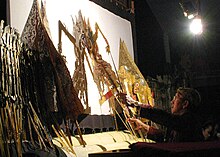
Back Wayang kulit AST Wayang Kulit BAN Wayang kulit BCL Wayang kulit Catalan Wayang kulit Spanish וויאנג קוליט HE Wayang kulit ID Wayang Kulit Italian ワヤン・クリ Japanese Wayang kulit JV
| Wayang kulit | |
|---|---|
 Wayang kulit performance with Dalang | |
| Types | Indonesian wayang form |
| Ancestor arts | Javanese |
| Originating culture | Indonesia |
| Originating era | Hindu—Buddhist civilisations |
| Wayang puppet theatre | |
|---|---|
| Country | Indonesia |
| Reference | 00063 |
| Region | Asia and the Pacific |
| Inscription history | |
| Inscription | 2008 (3rd session) |
| List | Representative |
| Wayang kulit, wayang golek, wayang klithik | |

Wayang kulit (Javanese: ꦮꦪꦁꦏꦸꦭꦶꦠ꧀) is a traditional form of shadow puppetry originally found in the cultures of Java and Bali in Indonesia.[1] In a wayang kulit performance, the puppet figures are rear-projected on a taut linen screen with a coconut oil (or electric) light. The dalang (shadow artist) manipulates carved leather figures between the lamp and the screen to bring the shadows to life. The narratives of wayang kulit often have to do with the major theme of good vs. evil.
Wayang kulit is one of the many different forms of wayang theatre found in Indonesia; the others include wayang beber, wayang klitik, wayang golek, wayang topeng, and wayang wong. Wayang kulit is among the best known, offering a unique combination of ritual, lesson and entertainment.
On November 7, 2003, UNESCO designated Wayang the flat leather shadow puppet (wayang kulit), the flat wooden puppet (wayang klitik), and the three-dimensional wooden puppet (wayang golek) theatre, as a Masterpiece of the Oral and Intangible Heritage of Humanity. In return for the acknowledgment, UNESCO required Indonesians to preserve the tradition.[2]
- ^ Ness, Edward C. Van; Prawirohardjo, Shita (1980). Javanese Wayang Kulit: An Introduction. Oxford University Press. ISBN 9780195804140.
- ^ ""Wayang puppet theatre", Inscribed in 2008 (3.COM) on the Representative List of the Intangible Cultural Heritage of Humanity (originally proclaimed in 2003)". UNESCO. Retrieved 25 March 2021.